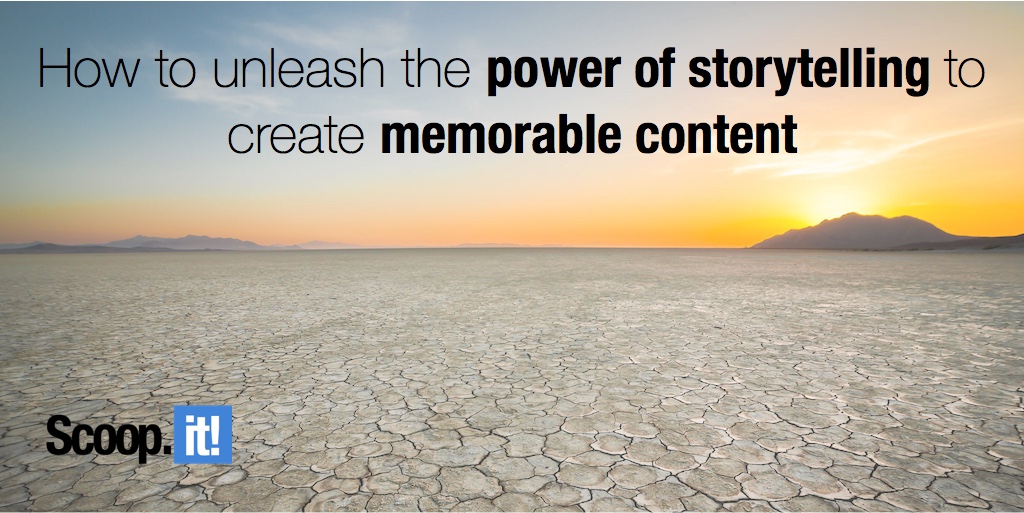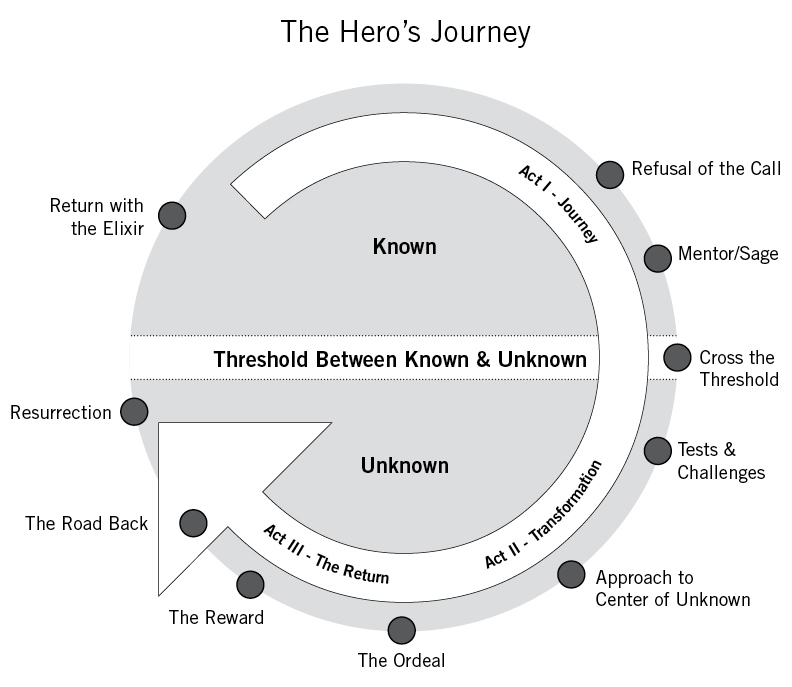
Once upon a time I had an awesome high school History teacher named Jesse. He was short, balding, sarcastic, slightly overweight and wore the same pair of washed out jeans almost every day. For our first day of freshman year he whisked us away on an impromptu field trip downtown to San Francisco’s Nike Town to demonstrate the concept of Americanization. He only ever responded to his first name, and if you dared address him as “Mister” you were promptly ignored. He was both intelligent and awkward, and somehow managed to make the process of veto’ing legislative bills in U.S. History riveting. But above everything else, he was a brilliant storyteller.
The best leaders, speakers, songwriters, teachers, coaches and marketers are all great storytellers. They connect with their audience on a human level and convey their message through a clearly organized narrative framework. They are neither dictators nor robots. Good storytellers consolidate event and comprehension, intertwine emotion into experience, and incite empathy in their audience. They transform complex information and present it in clear, relatable ways that people remember. Storytelling is fundamentally human and an indispensable tool with which to turn your content into memorable experiences for your readers.
Content marketing is a discipline about storytelling. Ironically, today’s focus on numbers and engagement metrics has caused us to lose track of the bigger picture of why we’re creating content in the first place. It has become a chore rather than a human extension of digital self-expression. Thus, it is essential for us to get back in touch with our inner humans and channel the power of storytelling to create truly compelling content and experiences for our audience.
Below are a few essential tips you can use to tell better stories that incite action.
It’s not about you, it’s about them
This is essential for any piece of content you create. Putting your readers at the heart of your story is the fastest way to building a loyal audience. You can easily create more compelling content by making your audience the hero of the story and focusing on your readers rather than on your product or brand.
Create a dramatic story arc
From Shakespeare to Spielberg, all great stories conform to and follow the same basic pattern of narrative structure, a concept introduced by American scholar Joseph Campbell as The Hero’s Journey. According to Campbell, enduring stories tend to share a dramatic arc along which a character journeys and eventually discovers unknown abilities with which he uses to later triumph over adversity. A great example of a major brand creating powerful, compelling content through stories is Coca-Cola’s “Journey” campaign.

Set up the scene and conflict
The hero, like your audience, is human. Grab their attention with an emotional hook that creates a sense of urgency and pulls them deeper into the narrative. Establishing the scene early on is a critical component of effective storytelling that engages the audience and gives them a framework within which they can identify personally and envision themselves meeting conflict.
Establish your own personal voice
If you want to get more people reading your content, you have to give it some personality and soul. The voice you choose should also match your brand as well as your desired message. This means first identifying your brand’s core personality traits and the values you want to communicate before crafting any piece of digital content, and then communicating them consistently. Here are a few tips to establishing a successful, powerful voice that sticks with your audience:
- Define your values. Identify the fundamental idea upon which your brand is based, and distill your brand values into a key concept or identity.
- Keep it consistent. A consistent tone conveys reliability and trust with your readers. According to content marketing expert Melissa Lafsky Wall, “From a branded content standpoint, your brand voice is the core tenet for creating every piece of digital content, be it a blog post, tweet, newsletter, or infographic…in order to communicate successfully, you have to distinguish and define your voice.”
Relate to your readers: be human and empathetic
“If you don’t feel it, you won’t remember it.” – Robert Dickman, The Elements of Persuasion
True story: people are more inclined to remember things they can identify with and relate to. Research has shown that eliciting empathy not only fosters trust but also engenders lasting effects that impact behavior. One of the core elements that made Jesse a great teacher wasn’t the fact that he looked like a hybrid teddy bear-Dave Matthews (also a true story). Or the fact that he possessed an endless, baffling and seemingly inhuman knowledge of random things. It was his authentic teaching style and the way in which he injected wit and personality into his lessons. We called him by his first name. We knew he loathed classical music with a fiery passion. He derived immense joy from dressing his infant son in onesies. His classes were discussions rather than lectures. In these ways, Jesse proved to his students that he wasn’t just another teacher or authority figure to whom we couldn’t relate. He established credibility by being human, and engaged us through empathy rather than authority. By showing he understood us on a human level, his classes were that much more powerful, engaging, and memorable.
Amplify with authenticity
The key to storytelling is authenticity, and it is a critical component to making your content more compelling, believable, and human. Authenticity also helps to establish a legitimate voice, and is an extremely efficient tool for creating powerful shared experiences that clearly convey your message. Here are some simple ways you can amplify your content with authenticity:
- Use first-person voice
- Be articulate and eloquent
- Relate with personal experience
- Adopt a warm tone or style
“Meaning resides in the thinking processes readers engage in as they read. The meaning they get from their reading is influenced both by their relevant prior knowledge and experiences and by the neural schema engaged to organize that particular text.” -Kendall Haven, The Science Behind the Startling Power of Story
Evoke emotion

Image by Josh Zyber.
Stories use emotional triggers to move people. Emotion drives decision-making, and thus is a powerful tool you can use to motivate and incite action from your readers. Establishing an emotional connection also plays a fundamental role in capturing and sustaining attention. Take Sarah Koenig from Serial. What makes the podcast so intriguing aren’t the events of the series themselves, but the expressive way in which Sarah tells the story. She’s not simply an anonymous narrator rattling off a one-dimensional enumeration of facts. She connects with her listeners by sharing with us her emotions and exposing her vulnerability, by asking questions, and by naturally reacting to newly revealed bits of information in the same ways we would. Great storytellers are human, and aren’t afraid to show it.
Contextualize
Facts are meaningless without context, and stories that lack organizational structure are disjointed and confusing. Content is more meaningful and memorable when presented in a series of unfolding events. Thus, providing your content with a detailed framework in the form of a clearly presented chronological progression will drive the narrative forward and bring your readers along for the ride:
- Give your content some structure. Research on learning has found that information presented in story structure is learned more efficiently and effectively than the same information presented through traditional academic writing.
- Use a frame. Humans better comprehend and derive meaning from information when it is organized within the framework of a story. According to powerful research conducted by Gamson & Modigliani in their 1987 study of the media’s use of framing devices in their coverage of current events, “Frames are central organizing ideas or story lines that provide meaning to an unfolding strip of events, weaving a connection among them. Frames that organize developments in chronological order and contain information about the causes and effects of relevant events should increase understanding.”
Create meaning with magic and mystery
Image by Smith Larry.
Both great songs and stories alike transcend their initial impact on the reader. They don’t fill in all the gaps or give away all the information. Instead, they create meaning through mystery and curiosity, and leave the audience intrigued and wanting more.
Be concise
In today’s age of dwindling attention spans and the shortening of online content, it can be tough out there for a digital storyteller. Here are a few things you can do to create comprehensive stories while working with constraints:
- Create suspense. Break your story into a series of segments rather than a lengthy and daunting passage of text that no one has time to read. This will create suspense as well as enhance SEO by linking back to previous series sections.
- Don’t cover everything. Focus on one or two specific angles within the broader story, and acknowledge the larger issue while staying focused on your specific points.
Accent the quirk

Image by Schimare.
Whatever you do, don’t be boring. People remember and share stories that are unique and original, not mundane. So don’t be afraid to get a little weird sometimes. Make your stories memorable by emphasizing the oddities and adding specific details around which to construct your narrative.
Use a cliffhanger
Of course, there are many other storytelling techniques you can use to help you become the next Spielberg of content marketing. But you’ll just have to stay tuned to find out…
Conclusion
Storytelling is a powerful and human tool that brings us together. The content you create should convey a clear and powerful story for your readers, what brought them to this point, and where they want to go in the future. Keep it authentic, human and simple.
Now, get out there and tell your story!
If you want to get 30 effective techniques to master content marketing along with valuable insights from 10+ influencers like Mark Schaefer, Rebecca Lieb, Lee Odden, Jason Miller or Ian Cleary, download our free eBook now!

Image by Trevor Bexon.


